oil specifications Hyundai Santa Fe 2014 Owner's Manual
[x] Cancel search | Manufacturer: HYUNDAI, Model Year: 2014, Model line: Santa Fe, Model: Hyundai Santa Fe 2014Pages: 711, PDF Size: 14.72 MB
Page 596 of 711
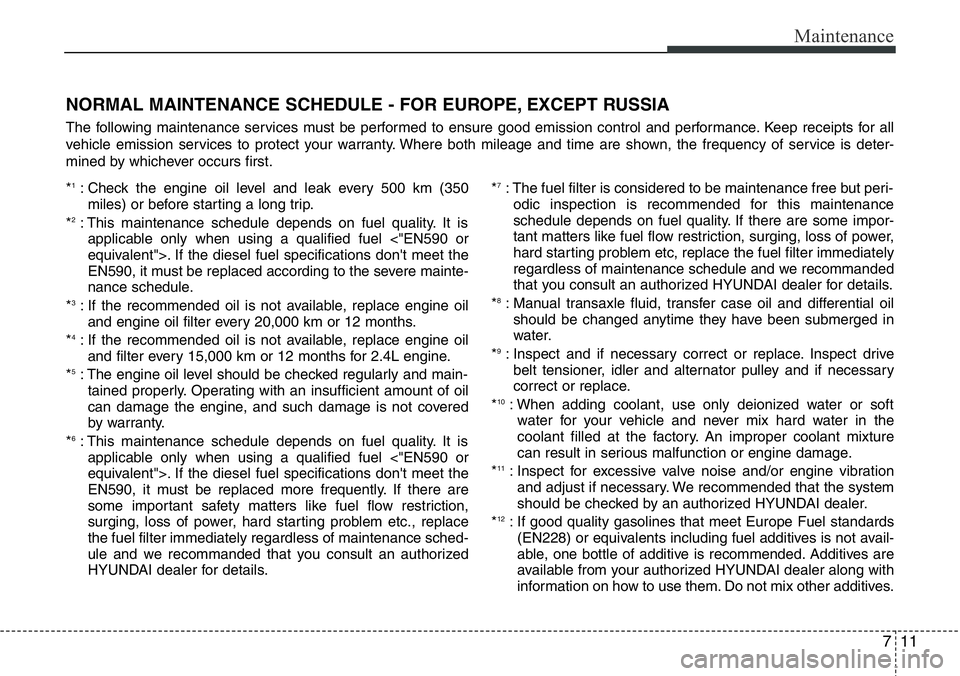
711
Maintenance
NORMAL MAINTENANCE SCHEDULE - FOR EUROPE, EXCEPT RUSSIA
The following maintenance services must be performed to ensure good emission control and performance. Keep receipts for all
vehicle emission services to protect your warranty. Where both mileage and time are shown, the frequency of service is deter-
mined by whichever occurs first.
*
1: Check the engine oil level and leak every 500 km (350
miles) or before starting a long trip.
*
2: This maintenance schedule depends on fuel quality. It is
applicable only when using a qualified fuel <"EN590 or
equivalent">. If the diesel fuel specifications don't meet the
EN590, it must be replaced according to the severe mainte-
nance schedule.
*
3: If the recommended oil is not available, replace engine oil
and engine oil filter every 20,000 km or 12 months.
*
4: If the recommended oil is not available, replace engine oil
and filter every 15,000 km or 12 months for 2.4L engine.
*
5: The engine oil level should be checked regularly and main-
tained properly. Operating with an insufficient amount of oil
can damage the engine, and such damage is not covered
by warranty.
*
6: This maintenance schedule depends on fuel quality. It is
applicable only when using a qualified fuel <"EN590 or
equivalent">. If the diesel fuel specifications don't meet the
EN590, it must be replaced more frequently. If there are
some important safety matters like fuel flow restriction,
surging, loss of power, hard starting problem etc., replace
the fuel filter immediately regardless of maintenance sched-
ule and we recommanded that you consult an authorized
HYUNDAI dealer for details.*
7: The fuel filter is considered to be maintenance free but peri-
odic inspection is recommended for this maintenance
schedule depends on fuel quality. If there are some impor-
tant matters like fuel flow restriction, surging, loss of power,
hard starting problem etc, replace the fuel filter immediately
regardless of maintenance schedule and we recommanded
that you consult an authorized HYUNDAI dealer for details.
*
8: Manual transaxle fluid, transfer case oil and differential oil
should be changed anytime they have been submerged in
water.
*
9: Inspect and if necessary correct or replace. Inspect drive
belt tensioner, idler and alternator pulley and if necessary
correct or replace.
*
10: When adding coolant, use only deionized water or soft
water for your vehicle and never mix hard water in the
coolant filled at the factory. An improper coolant mixture
can result in serious malfunction or engine damage.
*
11: Inspect for excessive valve noise and/or engine vibration
and adjust if necessary. We recommended that the system
should be checked by an authorized HYUNDAI dealer.
*
12: If good quality gasolines that meet Europe Fuel standards
(EN228) or equivalents including fuel additives is not avail-
able, one bottle of additive is recommended. Additives are
available from your authorized HYUNDAI dealer along with
information on how to use them. Do not mix other additives.
Page 607 of 711
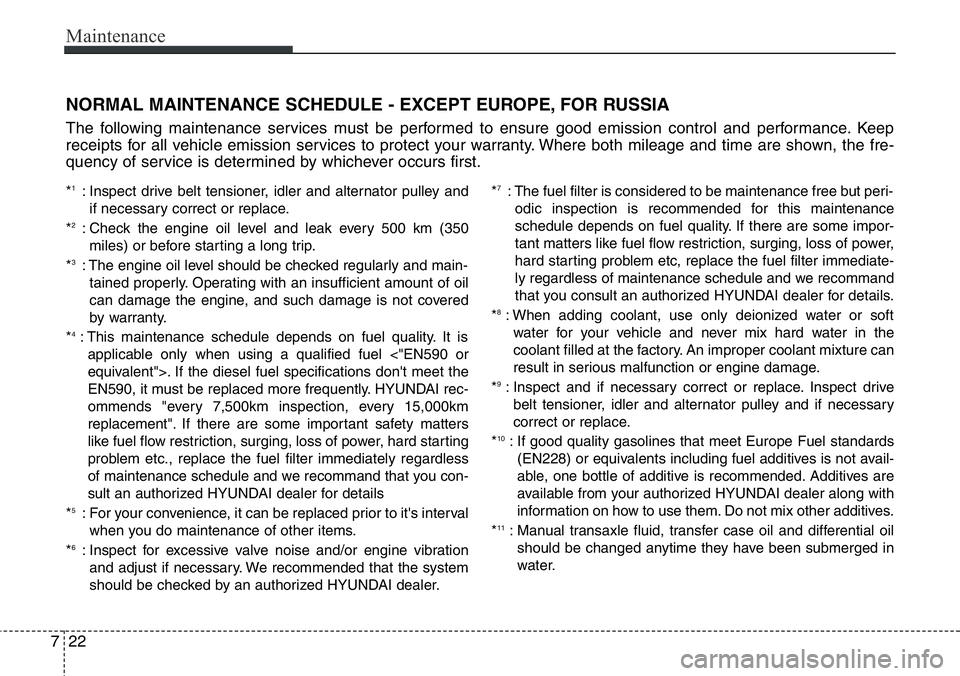
Maintenance
22 7
NORMAL MAINTENANCE SCHEDULE - EXCEPT EUROPE, FOR RUSSIA
The following maintenance services must be performed to ensure good emission control and performance. Keep
receipts for all vehicle emission services to protect your warranty. Where both mileage and time are shown, the fre-
quency of service is determined by whichever occurs first.
*1: Inspect drive belt tensioner, idler and alternator pulley and
if necessary correct or replace.
*
2: Check the engine oil level and leak every 500 km (350
miles) or before starting a long trip.
*
3: The engine oil level should be checked regularly and main-
tained properly. Operating with an insufficient amount of oil
can damage the engine, and such damage is not covered
by warranty.
*
4: This maintenance schedule depends on fuel quality. It is
applicable only when using a qualified fuel <"EN590 or
equivalent">. If the diesel fuel specifications don't meet the
EN590, it must be replaced more frequently. HYUNDAI rec-
ommends "every 7,500km inspection, every 15,000km
replacement". If there are some important safety matters
like fuel flow restriction, surging, loss of power, hard starting
problem etc., replace the fuel filter immediately regardless
of maintenance schedule and we recommand that you con-
sult an authorized HYUNDAI dealer for details
*
5: For your convenience, it can be replaced prior to it's interval
when you do maintenance of other items.
*
6: Inspect for excessive valve noise and/or engine vibration
and adjust if necessary. We recommended that the system
should be checked by an authorized HYUNDAI dealer.*
7: The fuel filter is considered to be maintenance free but peri-
odic inspection is recommended for this maintenance
schedule depends on fuel quality. If there are some impor-
tant matters like fuel flow restriction, surging, loss of power,
hard starting problem etc, replace the fuel filter immediate-
ly regardless of maintenance schedule and we recommand
that you consult an authorized HYUNDAI dealer for details.
*
8: When adding coolant, use only deionized water or soft
water for your vehicle and never mix hard water in the
coolant filled at the factory. An improper coolant mixture can
result in serious malfunction or engine damage.
*
9: Inspect and if necessary correct or replace. Inspect drive
belt tensioner, idler and alternator pulley and if necessary
correct or replace.
*
10: If good quality gasolines that meet Europe Fuel standards
(EN228) or equivalents including fuel additives is not avail-
able, one bottle of additive is recommended. Additives are
available from your authorized HYUNDAI dealer along with
information on how to use them. Do not mix other additives.
*
11: Manual transaxle fluid, transfer case oil and differential oil
should be changed anytime they have been submerged in
water.
Page 705 of 711
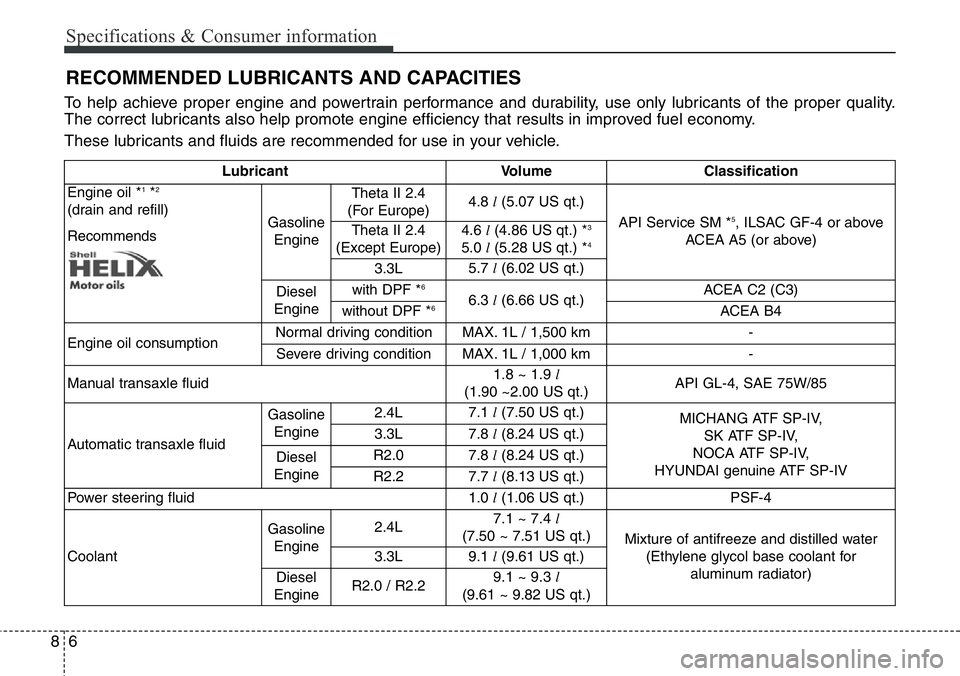
Specifications & Consumer information
6 8
RECOMMENDED LUBRICANTS AND CAPACITIES
To help achieve proper engine and powertrain performance and durability, use only lubricants of the proper quality.
The correct lubricants also help promote engine efficiency that results in improved fuel economy.
These lubricants and fluids are recommended for use in your vehicle.
Lubricant Volume Classification
Engine oil *
1*2
(drain and refill)
RecommendsGasoline
EngineTheta II 2.4
(For Europe)4.8 l(5.07 US qt.)
API Service SM *5, ILSAC GF-4 or above
ACEA A5 (or above)Theta II 2.4
(Except Europe)4.6 l(4.86 US qt.) *3
5.0 l(5.28 US qt.) *4
3.3L5.7 l(6.02 US qt.)
Diesel
Enginewith DPF *
66.3 l(6.66 US qt.)ACEA C2 (C3)
without DPF *6ACEA B4
Engine oil consumption Normal driving condition MAX. 1L / 1,500 km -
Severe driving condition MAX. 1L / 1,000 km -
Manual transaxle fluid 1.8 ~ 1.9 l
(1.90 ~2.00 US qt.)API GL-4, SAE 75W/85
Automatic transaxle fluid Gasoline
Engine2.4L7.1 l(7.50 US qt.)
MICHANG ATF SP-IV,
SK ATF SP-IV,
NOCA ATF SP-IV,
HYUNDAI genuine ATF SP-IV 3.3L7.8 l(8.24 US qt.)
Diesel
EngineR2.07.8 l(8.24 US qt.)
R2.27.7 l(8.13 US qt.)
Power steering fluid 1.0 l(1.06 US qt.)PSF-4
Coolant
Gasoline
Engine2.4L7.1 ~ 7.4 l
(7.50 ~ 7.51 US qt.)
Mixture of antifreeze and distilled water
(Ethylene glycol base coolant for
aluminum radiator)
3.3L9.1 l(9.61 US qt.)
Diesel
EngineR2.0 / R2.29.1 ~ 9.3 l
(9.61 ~ 9.82 US qt.)
Page 706 of 711
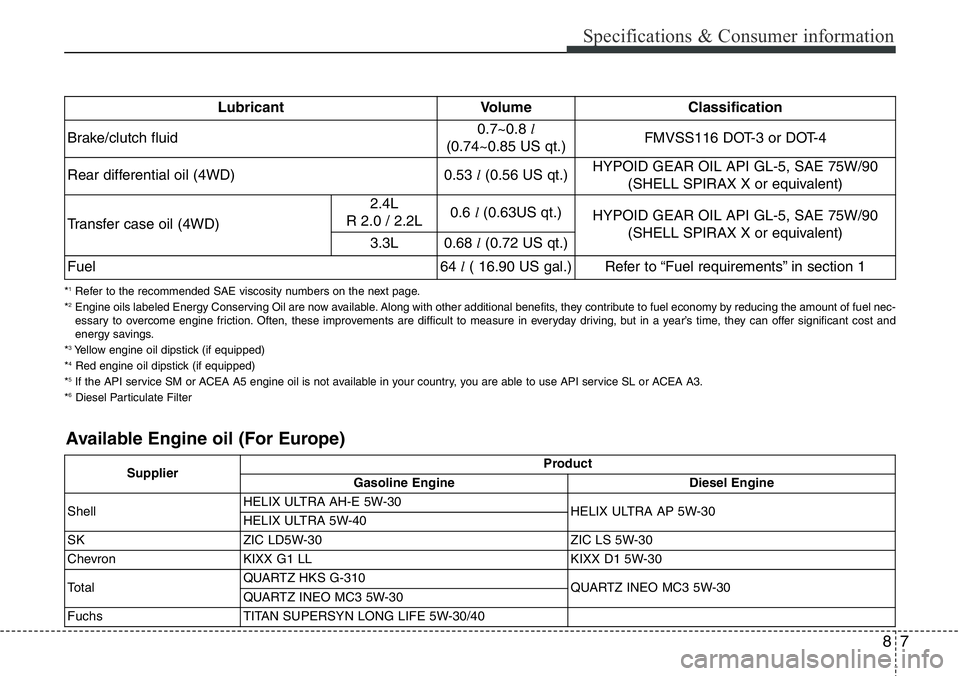
87
Specifications & Consumer information
*1Refer to the recommended SAE viscosity numbers on the next page.
*2Engine oils labeled Energy Conserving Oil are now available. Along with other additional benefits, they contribute to fuel economy by reducing the amount of fuel nec-
essary to overcome engine friction. Often, these improvements are difficult to measure in everyday driving, but in a year’s time, they can offer significant cost and
energy savings.
*
3Yellow engine oil dipstick (if equipped)
*4Red engine oil dipstick (if equipped)
*5If the API service SM or ACEA A5 engine oil is not available in your country, you are able to use API service SL or ACEA A3.
*6Diesel Particulate Filter
Lubricant Volume Classification
Brake/clutch fluid0.7~0.8 l
(0.74~0.85 US qt.)FMVSS116 DOT-3 or DOT-4
Rear differential oil (4WD)0.53 l(0.56 US qt.)HYPOID GEAR OIL API GL-5, SAE 75W/90
(SHELL SPIRAX X or equivalent)
Transfer case oil (4WD) 2.4L
R 2.0 / 2.2L0.6 l(0.63US qt.)
HYPOID GEAR OIL API GL-5, SAE 75W/90
(SHELL SPIRAX X or equivalent)
3.3L0.68 l(0.72 US qt.)
Fuel64 l( 16.90 US gal.)
Refer to “Fuel requirements” in section 1
Available Engine oil (For Europe)
SupplierProduct
Gasoline Engine Diesel Engine
ShellHELIX ULTRA AH-E 5W-30
HELIX ULTRA AP 5W-30
HELIX ULTRA 5W-40
SK ZIC LD5W-30 ZIC LS 5W-30
Chevron KIXX G1 LL KIXX D1 5W-30
TotalQUARTZ HKS G-310
QUARTZ INEO MC3 5W-30
QUARTZ INEO MC3 5W-30
Fuchs TITAN SUPERSYN LONG LIFE 5W-30/40
Page 707 of 711
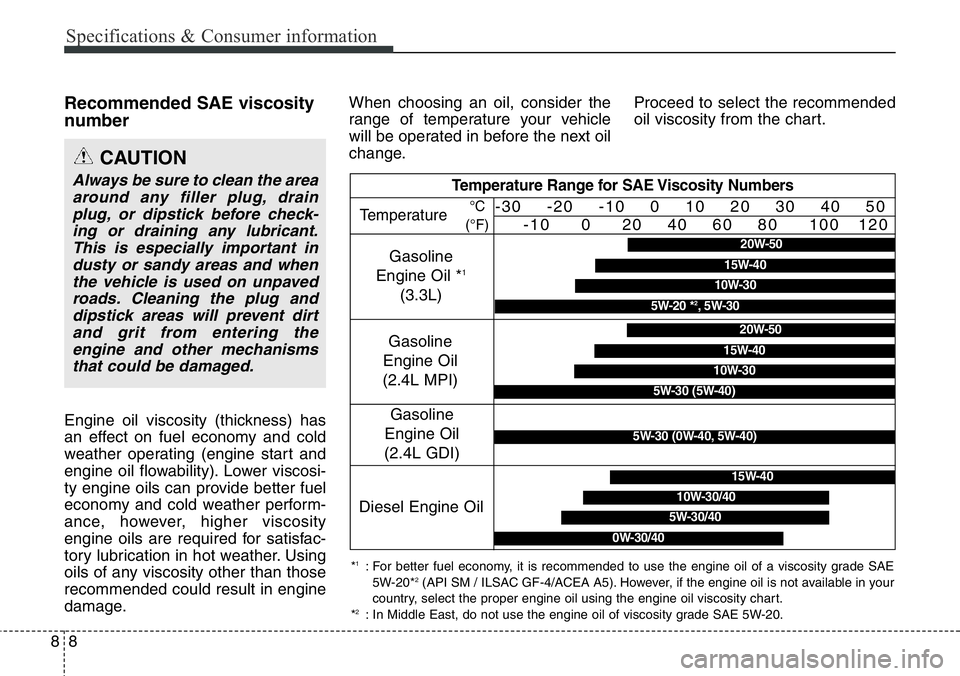
Specifications & Consumer information
8 8
Recommended SAE viscosity
number
Engine oil viscosity (thickness) has
an effect on fuel economy and cold
weather operating (engine start and
engine oil flowability). Lower viscosi-
ty engine oils can provide better fuel
economy and cold weather perform-
ance, however, higher viscosity
engine oils are required for satisfac-
tory lubrication in hot weather. Using
oils of any viscosity other than those
recommended could result in engine
damage.When choosing an oil, consider the
range of temperature your vehicle
will be operated in before the next oil
change.Proceed to select the recommended
oil viscosity from the chart.
CAUTION
Always be sure to clean the area
around any filler plug, drain
plug, or dipstick before check-
ing or draining any lubricant.
This is especially important in
dusty or sandy areas and when
the vehicle is used on unpaved
roads. Cleaning the plug and
dipstick areas will prevent dirt
and grit from entering the
engine and other mechanisms
that could be damaged.
*1: For better fuel economy, it is recommended to use the engine oil of a viscosity grade SAE
5W-20*2(API SM / ILSAC GF-4/ACEA A5). However, if the engine oil is not available in your
country, select the proper engine oil using the engine oil viscosity chart.
*
2: In Middle East, do not use the engine oil of viscosity grade SAE 5W-20.
Temperature Range for SAE Viscosity Numbers
Temperature
Gasoline
Engine Oil *1
(3.3L)
°C
(°F)-30 -20 -10 0 10 20 30 40 50
-10 0 20 40 60 80 100 120
Diesel Engine Oil5W-30/40
15W-40
10W-30/40
0W-30/40
20W-50
10W-30
15W-40
5W-20 *2, 5W-30
Gasoline
Engine Oil
(2.4L MPI)20W-50
10W-30
15W-40
5W-30 (5W-40)
Gasoline
Engine Oil
(2.4L GDI)
5W-30 (0W-40, 5W-40)
Page 710 of 711
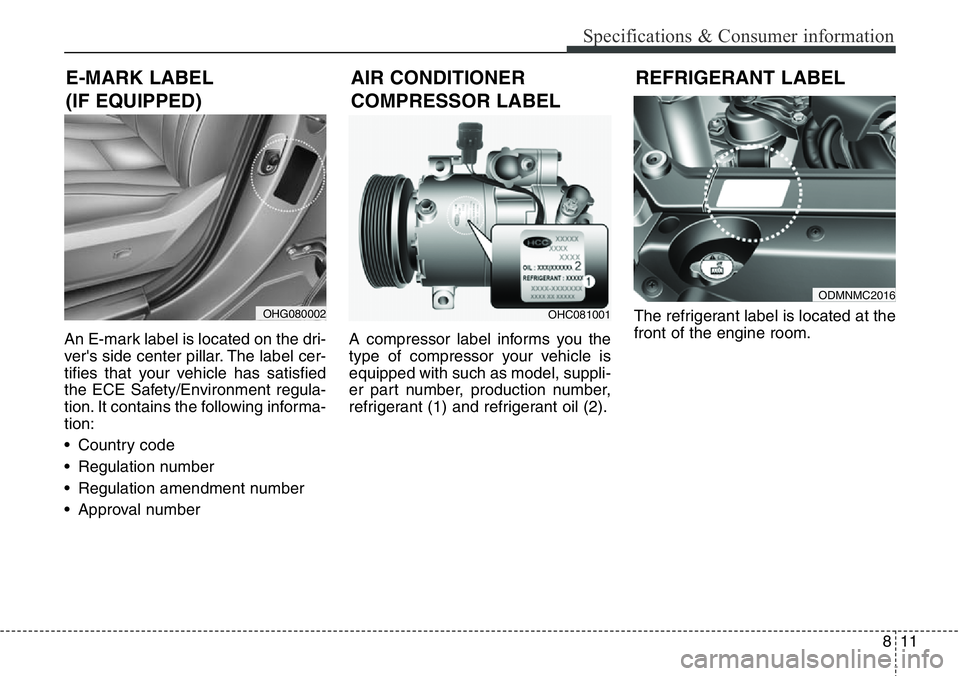
811
Specifications & Consumer information
An E-mark label is located on the dri-
ver's side center pillar. The label cer-
tifies that your vehicle has satisfied
the ECE Safety/Environment regula-
tion. It contains the following informa-
tion:
• Country code
• Regulation number
• Regulation amendment number
• Approval numberA compressor label informs you the
type of compressor your vehicle is
equipped with such as model, suppli-
er part number, production number,
refrigerant (1) and refrigerant oil (2).The refrigerant label is located at the
front of the engine room.
OHC081001
AIR CONDITIONER
COMPRESSOR LABEL
OHG080002
REFRIGERANT LABEL
ODMNMC2016
E-MARK LABEL
(IF EQUIPPED)